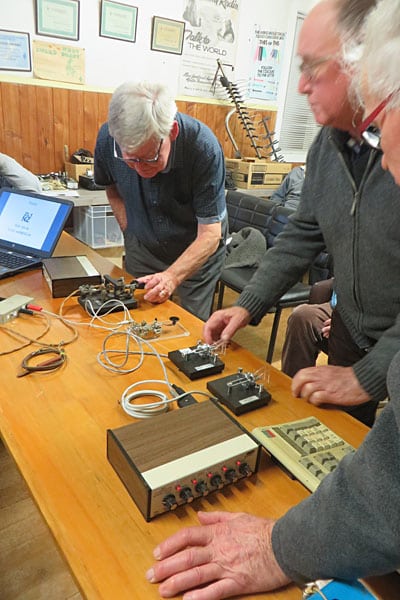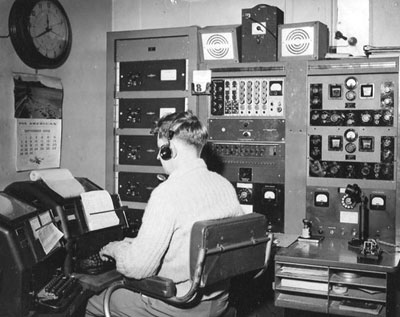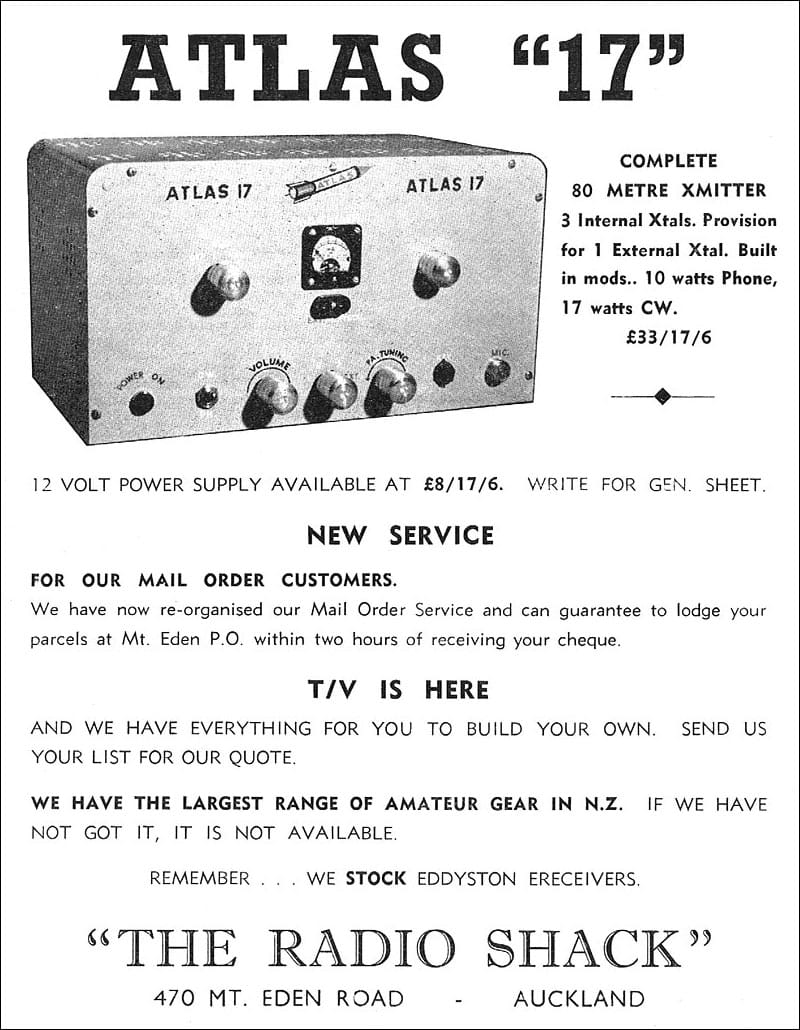This is a fortnightly newsletter about the New Zealand Net. If you would like to be notified by email when a new edition is published, please contact ZL1NZ.
Browse our Newsletter Archive and List of Net Tips.
Featured key

Chrome-plated Supreme key owned by ZL4KA. Photo: ZL3TK
By Stan ZL3TK
As a natural progression from SM5LNE’s bare-brass Supreme key shown in NZ Net News NR57, here is an instantly recognizable, though very rare, family member, owned by Ruth ZL4KA. The chrome plating and the deep-brown finger guard contribute to its rarity, while the tapered steel pivot pin and spring tension adjusting screw are ubiquitous in this type of key. The casting flaws so typical of Supreme keys have been largely eliminated due to the rather generous layer of chrome.
From many years ago, I remember reading that Tricity House in Christchurch produced a ‘Limited Edition’ chrome plated version of their standard brass key. The actual quantity wasn’t stated, however it seems to have been a small number.
* If you have an interesting key for this feature, please send me a nice clear photo and a few words describing it.
Quick notes

Remember, this Sunday night is the deadline for Straight Key Night log submissions which means … the top place-getters will be announced Monday on NZ Net.
It certainly seems to be contest season. Next up is the annual Memorial Contest on 3-4 July.
A shocking experience
By Bob ZL1AYN
I took the 15wpm morse test for my overseas licence in Auckland in 1966. The NZ Post office had hired the Mocambo Nightclub as a test venue and the written and morse tests were being conducted for quite a few hams.
I had passed the 15 wpm receiving on tape and had to wait my turn to do a sending test run on a Supreme straight key with a copper penny as the disc. I noticed that the guys on the key before me had their fingers on the top of the knob whereas military operators were trained to grip the key knob with the thumb and little finger below the knob on top of the disc, the other fingers on top with the fingertips forward of the knob for control when sending in a moving vehicle going cross-country.
So when I hopped on the key for my turn I gripped the key as I had been taught, only to learn that the key disc was live! I got a good tingle which changed my key grip somewhat.
The tester remarked afterwards that I was a bit “ditty” at the start but was alright when I settled into my text!
“Yeah, right!”
But I passed, and ZL1AYN was on the DX bands.
Photo flashback
From QST, June 1976: VE3HGM, Jim Korenev, is a determined young man who was first licensed at age 11, after attending code classes held by the Windsor ARC. At age 12 Jim took, and passed, his Advanced class examination. Now 13, VE3HGM is the youngest Canadian to hold the DXCC Award. He also holds the WAS, WAC and CP [Code Proficiency – Ed] with 30wpm endorsement. Jim’s current objective, aside from working DX, is to teach himself to type well enough to put down on paper the 50wpm he can copy in his head.
VE3HGM, Jim Korenev, is a determined young man who was first licensed at age 11, after attending code classes held by the Windsor ARC. At age 12 Jim took, and passed, his Advanced class examination. Now 13, VE3HGM is the youngest Canadian to hold the DXCC Award. He also holds the WAS, WAC and CP [Code Proficiency – Ed] with 30wpm endorsement. Jim’s current objective, aside from working DX, is to teach himself to type well enough to put down on paper the 50wpm he can copy in his head.
Travelling CW show
On 15 June I gave a talk on CW at the Franklin Amateur Radio Club in Pukekohe, south Auckland.
One of the highlights for me was when club member Ian Sexton ZL4PZ joined me at the front of the hall to talk about his homebrew CMOS Superkeyer and keyboard interface that he had built about 40 years ago.

Ian ZL4PZ with his CMOS Superkeyer and Neil ZL1NZ with assorted keys

Peter ZL1PJH, Ted ZL1BQA and Gary ZL1WGL check out the keys
He is a WW2 veteran and will be 101 years old on 3 July.
Ian got his ham ticket in September 1939. Two days later, New Zealand declared war and shut down all amateur radio before he could even make his first contact. He then trained in radar and was sent to Guadalcanal where he guided US fighter planes (from the ground) as they attacked Japanese bombers which were attempting to destroy the airfield. There’s lots of amazing information in this short autobiography that Ian wrote a couple of years ago.
My presentation covered a bit of Morse history, some Auckland Radio stories, tips on learning the code, a look at various types of key and – naturally – an introduction to the New Zealand Net.
Thanks to Peter ZL1PJH for the invitation and to the Franklin Amateur Radio Club for their hospitality. Incidentally, the club’s newsletter is called QUA. How appropriate!
Photos: Tom ZL1TO
Memories of Aeradio message forms
By Stan ZL3TK
In NZ Net News NR57, an ‘Aeradio Message Form’ C.A. Form 78, is shown. Gerard ZL2GVA was close when he surmised, “…it looks more like an internal Civil Aviation form rather than for public use.”
 Apparently they were used internally as an intermediate step between CAA Aeradio reception/transmission and the composition of an ‘NZPO Inland Telegram’. CAA was of course a different government department to the NZPO, and although both were often found working in the same building, each jealously guarded its own protocols and checking procedures.
Apparently they were used internally as an intermediate step between CAA Aeradio reception/transmission and the composition of an ‘NZPO Inland Telegram’. CAA was of course a different government department to the NZPO, and although both were often found working in the same building, each jealously guarded its own protocols and checking procedures.
When I was a child, our occasional annual holidays were subsidised by a range of pseudo Uncles and Aunties who generously provided our accommodation. One such family lived in Takutai Avenue, Bucklands Beach, Auckland, which to me was ‘out of this world’, with its white, cockle shell-strewn pathway from the back door to a chicken coop at the top of the cliff above Little Bucklands.
One of the neighbours was Frank Bissmire, a radio operator at the Musick Memorial receiving station. The year, I believe, was 1959, so I’d have been thirteen. My keen interest in radio was already evident and someone kindly arranged for Mr Bissmire (we showed our elders respect in those days) to show me through the station.
The Aeradio section at Musick Point comprised a sole operator up in the tower, before it was turned into a teletype room. I remember going up the stairs and arriving at the open door to a small room, but had difficulty advancing farther, due to a huge pile of yellow pads stacked almost right across the floor. The operator, whose name I can no longer recall, was crammed into one corner and said the pads had been dumped there a couple of years before, only because there was no room anywhere else on the station to store them. A 600 ohm open-wire feeder was draped across the room at head-height from one of the western windows. ‘Health and Safety’ would surely have something to say today about both the feeder, and the lack of easy egress.

Aviation radio operator Andy Bennie in the tower at Musick Point, c1959
After instructing me to step around and over the pile, he enthusiastically showed me how he communicated with aircraft in flight. When it was time to leave, he indicated that I should take a memento of my visit, and since he was keen to have better access to his operating desk, he gladly reduced the size of the pile of pads by handing one to me. Although the individual pages were very thin, each pad was about 7/8 inch thick (old days measurement) with a glued top edge. Whether the pad I was given was from the same batch of 10,000 as shown printed in October 1950, I do not know, however the pages looked identical.
Many years later while away working overseas, most of my worldly goods were stored in a garage beneath a house in Mt Eden. Upon returning I found the garage had been flooded. Among the contents of the ruined boxes, now multi-coloured by mould and fungus, was my pad of CAA Aeradio Message Forms, which went unceremoniously to its final resting place c1985.
Audio challenge:
Listen to the following Morse Code, then tell me, be email or radiogram, where one would find these words (it’s a New Zealand source).
In our previous newsletter, the Audio Challenge contained a traffic list from Blåvand Radio OXB on 500 kHz and I asked for the callsigns of the stations on the list.
I received correct answers from ZL1ANY, ZL1BBW, ZL2GVA and ZL3TK.
Preservation: Kapiti Museum to ditch radios
Continuing our series on New Zealand museums with radio collections, this time it’s a special and important announcement.
 No sooner had I featured the Kapiti Coast Museum in NZ Net News, than they announced they were planning to dispose of their radio collection. They have posted a photo gallery and are asking for expressions of interest by the end of this month.
No sooner had I featured the Kapiti Coast Museum in NZ Net News, than they announced they were planning to dispose of their radio collection. They have posted a photo gallery and are asking for expressions of interest by the end of this month.
There are heaps of boat anchor radios shown (some are reported to have come from the collection of famed radio amateur Jock White), but I have to say that the vast majority of them look to be in poor condition. Although I’d love to rescue a few, I just don’t have the space, skills or time to resurrect them.
Please spread the word, so that these old radios don’t end up the landfill. Sadly, I think we are not many years away from seeing a glut of boat anchor gear offered for sale, and very little demand for it.
Video: The Mysterious Benedict Society
Here’s our secret plan to get today’s young people interested in CW!
In this trailer for a new Disney series, pay special attention to the brief scene at 24 seconds into the video.
Now, who can tell me what device the boy is using? I’ll award a virtual “good on ya” in the next newsletter to the person with the most specific (and correct) answer.
Net tip:
Due to an abundance of other content for this issue of NZ Net News, there is no Net Tip. But if you have a question or topic you’d like to see covered in a future Net Tip, please let me know.
Advertising archive

Break-In magazine, June 1960.
Anyone familiar with this rig?
Suggestions?
If you have suggestions on how to make the NZ Net better, or things you’d like to see covered in these updates, please contact ZL1NZ. You might even like to write something for the newsletter.
Thanks for reading, and I hope to see you soon on the NZ Net!
—
Neil Sanderson ZL1NZ, Net Manager
New Zealand Net (NZ NET)
3535.0 kHz at 9pm NZT Mon-Fri




